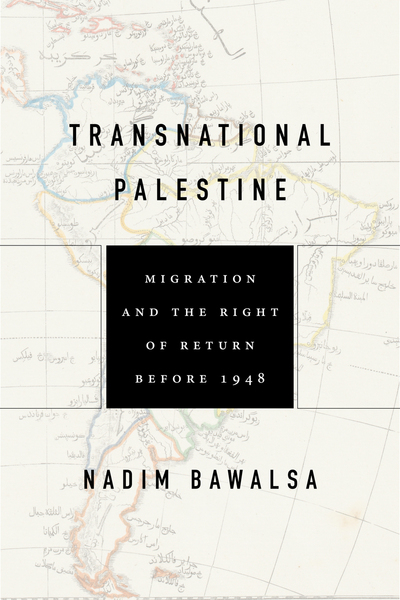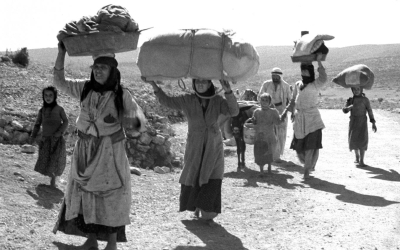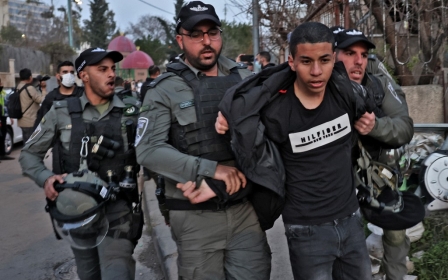How a century of exile forged Palestinian national consciousness

My book,Transnational Palestine: Migration and the Right of Return Before 1948, examines the migration of Palestinians to Latin America beginning in the late 19th century, and the role of transnational political activism in shaping a Palestinian diaspora community, jaaliya, during the interwar period.
In doing so, it offers the first transnational history of the development of Palestinian national consciousness in the first half of the 20th century.
Drawing on Arabic, English, French and Spanish sources from archives and personal collections in Palestine, England, Mexico and Chile, the book expands Palestinian historiography to embrace transnational historical analysis through migration and diaspora studies.
Transnational Palestine examines how, in the interwar years, British mandate authorities in London and Jerusalem used the 1925 Palestinian Citizenship Order-in-Council - enforced throughout the entirety of the British mandate for the regulation of Palestinian nationality and citizenship - to exclude thousands of Palestinian migrants from citizenship in order to prioritise the in-migration and naturalisation as Palestinian of Jewish immigrants.
New MEE newsletter: Jerusalem Dispatch
Sign up to get the latest insights and analysis on Israel-Palestine, alongside Turkey Unpacked and other MEE newsletters
On the one hand, Transnational Palestine explores in detail the ramifications of the ordinance for Palestinian migrants, who numbered roughly 40,000 by 1936, who had an incontestable right to Palestinian nationality since the Treaty of Lausanne came into force in August 1924, and who thus became stateless nationals carrying obsolete Ottoman travel documents affording them no consular representation or protection.
On the other, it examines Arabic and Spanish petitions and periodicals from Arabic-speaking migrant communities across Latin America to show how the exclusionary ordinance informed the emergence of new networks of communication and solidarity among Palestinian and other Arabic-speaking migrants in the diaspora and in Palestine.
Resistance strategies
From Santiago, Buenos Aires, Lima and Sao Paulo, to Mexico City to Monterrey, Paris and Jerusalem, Palestinian migrants, their allies in the Americas and their counterparts in Palestine discussed strategies for resisting oppressive British - and French - mandate governance, including citizenship rejections meted out to thousands of Palestinian migrants.
They did this in newspapers, social clubs and associations, political organisations and committees, and in hundreds of petitions delivered to local and international governing bodies, including the League of Nations.
Palestinian national thought in the first half of the 20th century was never bound to geographic Palestine, but developed as a thoroughly transnational process
Apart from a handful of works exploring Palestinian global circulations before 1948, Palestinians remain largely absent from transnational historical analysis.
That is, the historical study of the Palestinian people has largely been confined to geographic Palestine, the land between the Jordan River and the Mediterranean Sea, overlooking remarkable narratives that span the globe from the Peruvian and Chilean Andes to ports in the Philippines.
As a result, Palestinians have rarely been written into histories of migration and diaspora formation, cultural and material exchange, settlement and assimilation, or transnational political activism around the turn of the 20th century, narratives associated with many other peoples, including those from the Middle East.
Transnational Palestine thus argues that the interconnected transnational networks Palestinians and other Arabic-speaking migrants forged throughout the early 20th century were essential to the growth of Middle Eastern migrant communities in Latin America, to the formation of a specifically Palestinian diaspora community, and to the development of Palestinian national consciousness.
In this way, Transnational Palestine argues that the development of Palestinian national thought in the first half of the 20th century was never bound to geographic Palestine, but developed as a thoroughly transnational process.
A critical role
As historian Sebastian Conrad puts it, “the increase in transnational interrelationships” at the turn of the 20th century can "be seen as one of the most important factors contributing to the consolidation of national categories".
Indeed, Transnational Palestine shows how Palestinian migrants and the transnational networks they established through their activism were critical to the Palestinian nationalist movement in Palestine.
Finally, Transnational Palestine projects the narrative of a Palestinian struggle for a right of return to Palestine 23 years back to 1925. While the 1948 Nakba remains a seminal event in Palestinian historiography, Transnational Palestine offers that the 1925 citizenship ordinance in significant ways set a precedent for the settler-colonial Israeli regime’s apartheid policies of permanently displacing Palestinians.
That the narratives of dispossession and permanent exile thought to have begun in 1948 were already part of Palestinian collective memory and socialisation for nearly 30 years by the time of the Nakba suggests that Palestinians experienced and made sense of their post-1948 and post-1967 diasporas in fundamentally unique ways.
It indicates that for the different waves of Palestinian exiles since 1948, return was already a fraught concept, including the notion of having a legal right to it, given the precedent set by British colonial authorities of denying them this right.
Transnational Palestine proposes that modern Palestinian history is in significant ways a scaffolding of intergenerational diaspora experiences that compel us to ponder how Palestinians worldwide have been experiencing, internalising, and talking about permanent exile and dispossession for nearly a century.
In other words, the inability of tens of thousands of Palestinians to secure legal means of remaining connected to Palestine in the 23 years prior to the Nakba indicates the longevity of Palestinian displacement and the critical role that international law has played in ensuring its permanence since the early interwar era, through 1948, and to this day.
Transnational Palestine thus invites countless questions about where we, as exiled Palestinians, may go from here.
The views expressed in this article belong to the author and do not necessarily reflect the editorial policy of Middle East Eye.
Middle East Eye delivers independent and unrivalled coverage and analysis of the Middle East, North Africa and beyond. To learn more about republishing this content and the associated fees, please fill out this form. More about MEE can be found here.







